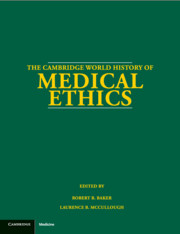Book contents
- Frontmatter
- PART I AN INTRODUCTION TO THE HISTORY OF MEDICAL ETHICS
- PART II A CHRONOLOGY OF MEDICAL ETHICS
- PART III DISCOURSES OF MEDICAL ETHICS THROUGH THE LIFE CYCLE
- PART IV THE DISCOURSES OF RELIGION ON MEDICAL ETHICS
- PART V THE DISCOURSES OF PHILOSOPHY ON MEDICAL ETHICS
- PART VI THE DISCOURSES OF PRACTITIONERS ON MEDICAL ETHICS
- PART VII THE DISCOURSES OF BIOETHICS
- PART VIII DISCOURSES ON MEDICAL ETHICS AND SOCIETY
- Ethical and Legal Regulation of Medical Practice and Research
- B Medical Ethics, Imperialism, and the Nation-State
- C Medical Ethics and Health Policy
- 59 Making Distinctions “Natural”: The Science of Social Categorization in the United States in the Twentieth Century
- 60 History of Public Health Ethics in the United States
- 61 Ethics and Health Policy in the United Kingdom and the United States: Legislation and Regulation
- 62 Ethical Issues in Organ Transplantation in the United States
- 63 Defining and Redefining Life and Death
- Appendix: Biographies: Who Was Who in the History of Medical Ethics
- Bibliography
- Index
63 - Defining and Redefining Life and Death
from C - Medical Ethics and Health Policy
Published online by Cambridge University Press: 28 May 2012
- Frontmatter
- PART I AN INTRODUCTION TO THE HISTORY OF MEDICAL ETHICS
- PART II A CHRONOLOGY OF MEDICAL ETHICS
- PART III DISCOURSES OF MEDICAL ETHICS THROUGH THE LIFE CYCLE
- PART IV THE DISCOURSES OF RELIGION ON MEDICAL ETHICS
- PART V THE DISCOURSES OF PHILOSOPHY ON MEDICAL ETHICS
- PART VI THE DISCOURSES OF PRACTITIONERS ON MEDICAL ETHICS
- PART VII THE DISCOURSES OF BIOETHICS
- PART VIII DISCOURSES ON MEDICAL ETHICS AND SOCIETY
- Ethical and Legal Regulation of Medical Practice and Research
- B Medical Ethics, Imperialism, and the Nation-State
- C Medical Ethics and Health Policy
- 59 Making Distinctions “Natural”: The Science of Social Categorization in the United States in the Twentieth Century
- 60 History of Public Health Ethics in the United States
- 61 Ethics and Health Policy in the United Kingdom and the United States: Legislation and Regulation
- 62 Ethical Issues in Organ Transplantation in the United States
- 63 Defining and Redefining Life and Death
- Appendix: Biographies: Who Was Who in the History of Medical Ethics
- Bibliography
- Index
Summary
INTRODUCTION
Debates about the definitions of life and death have played important roles in the history of biomedical ethics (see Chapter 38). After exploring some of those meanings, this chapter examines the positions taken prior to the time of the transplantation of human organs (see Chapter 62). This is followed by a more extensive discussion of the definition of death in the transplant era and controversies that can be expected over that definition in the coming century.
CONCEPTUAL ISSUES
The terms, “life” and “death,” each have a number of different meanings. They are terms playing important roles in biology, sociocultural communication, and in moral, legal, and public policy debates.
The Meaning of Life
To know what it means for a human to be dead, one must first reflect on what it means to be alive. The Webster's Third New International Dictionary of the English Language Unabridged (Gove 1971, 3333) contains no fewer than twenty-one definitions of the term, “life,” many of which include multiple subcategories. The first group of definitions view life as a biological phenomenon; the second group view it more metaphorically as the existence of anything such as a culture. A third group of definitions use the term to assign moral or legal or public policy status to an entity.
Biological Uses
The first definition is that life means “an animate being; the quality that distinguishes a vital and functional being from a dead body or purely chemical matter.”
- Type
- Chapter
- Information
- The Cambridge World History of Medical Ethics , pp. 684 - 692Publisher: Cambridge University PressPrint publication year: 2008



